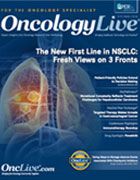A Time for Hope
Although lung cancer still causes more deaths than any other type of malignancy not only in the United States but throughout the world, there’s a sense of excitement in the air these days when it comes to helping people with this disease.
OncLive Chairman,
Mike Hennessy
Although lung cancer still causes more deaths than any other type of malignancy not only in the United States but throughout the world, there’s a sense of excitement in the air these days when it comes to helping people with this disease.
The reasons for that spirit of optimism are evident. The pace of discovery in this eld during the past 5 years has been truly breathtaking with the expansion of targeted therapies, where there are now several classes of agents available, and the growth of immunotherapy, which once was considered a poor strategy for this tumor type.
The milestones of this changing landscape are featured throughout this issue of OncologyLive.
Our cover package, “The New First Line in NSCLC: Fresh Views on 3 Fronts,” provides expert insights on the many questions generated by the wealth of new approaches now available to clinicians.
Remarkably, the conversation about which of these therapies to employ in the front line for patients with advanced or metastatic disease is being conducted simultaneously in 3 key areas: EGFR inhibitor therapy, ALK inhibitor treatment, and immunotherapy.
For a taste of the future, we direct your attention to the Clinical Trial Spotlight, titled “Tepotinib Takes Aim at Novel MET Mutation in Lung Cancer Trial.” The ability to sequence the lung cancer genome has resulted in the identification of a MET skipping mutation that seems to respond well to inhibitors directed at this pathway. If this trial and other clinical studies succeed, another group of patients will be able to benefit from biomarker- driven therapy.
Finally, the quest to personalize immunotherapy is the subject of our Precision Medicine in Oncology® offering, “Dual Biomarker Signature Holds Predictive Promise for Response to Anti-PD-L1 Therapy in NSCLC.”
This is a vital undertaking for the academic and industry research establishments. We can’t expect public or private insurers to pay for expensive therapies without a better idea of which patients would most benefit from them—just as we can’t expect patients to forgo a potentially life-altering drug unless there is a high degree of certainty that it would not help them.
As we wind up another year of oncology drug development, there are more reasons than ever to be hopeful. We know, of course, that hundreds of thousands of people worldwide are still dying of this disease. So when there’s forward progress, we like to celebrate—and then keep on pushing for greater advancements.
Thank you for sharing this journey with us.




